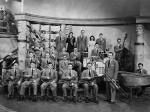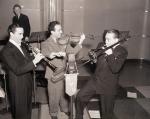![header=[Marker Text] body=[Trombonist Tommy Dorsey (1905-56) and saxophonist Jimmy Dorsey (1904-57) were key figures of the "big band" era. Born within three miles of here, both grew up and began their musical careers in Shenandoah. Until 1935 the brothers performed together. They led separate orchestras during the next 18 years before being reunited. Frank Sinatra was a featured singer with Tommy's orchestra, 1940-42] sign](http://explorepahistory.com/kora/files/1/10/1-A-34F-139-ExplorePAHistory-a0l3l6-a_450.gif)
Mouse over for marker text
Name:
The Dorsey Brothers [Great Depression]
Region:
Valleys of the Susquehanna
County:
Schuylkill
Marker Location:
5 North Main Street (PA 924), Shenandoah
Dedication Date:
September 7, 1991
Behind the Marker
Before there was Elvis, there were the Dorsey Brothers. From mid-1930 through the mid-1950s, the Dorsey brothers' bands were among the most popular in the United States. Born and reared in Shenandoah, a coal town in northeast Pennsylvania, the brothers learned music from their father, who led a local marching band. Both learned multiple instruments before Jimmy gravitated to the clarinet and saxophone, and Tommy to the trombone.
Shenandoah may have been a small town, far from the nightclubs and dance halls of Chicago, New York, or Philadelphia, but there, as in small towns across the nation, kids were able to hear the latest music of the day by turning on the radio or purchasing a new record for the parlor phonograph. In Shenandoah, the Dorsey brothers fell in love with jazz and developed a fantastic technique on their instruments.
In the mid-1920s the brothers joined two of the nation's most popular white dance bands. After touring with the Paul Whiteman and Jean Goldkette Orchestras they settled in New York City, where they were in high demand as studio musicians. Jimmy soon began recording with white jazz pioneers Bix Beiderbecke and Red Nichols. After joining Nichols' The Five Pennies in the early 1930s he quickly established himself as a leading reed player. The Dorsey brothers were part of a new movement in jazz called "swing," a highly orchestrated, hard-driving form of jazz with a steady rhythm and tight arrangements.
The new swing bands were led by top-flight soloists rather than the "baton twirlers," of the 1920s. Riding the first wave of the swing craze, the brothers started their own band in 1934, which became an instant sensation. But the band soon broke up after the two strong-willed brothers had a falling out, supposedly after Tommy walked off the stage when he didn't like the tempo his brother had set for a song. The brothers' feud would last for close to a decade.
Dance bands achieved unprecedented popularity during the Second World War, and the Tommy Dorsey Band became one of the most popular of the day. Featuring soloists like trumpeter Bunny Berrigan, a young Frank Sinatra, Jo Stafford, and Tommy himself on trombone, the band turned out hit after hit. Among them were Sinatra's "Violets for Your Furs" and "This Love of Mine," Jo Stafford's "For You" and "Embraceable You," and the band's biggest hit of all, "I'll Never Smile Again."
Jimmy Dorsey also put together an enormously successful orchestra, scoring hits with singers Helen O'Connell and Bob Eberly that included "Amapola," "Green Eyes," and "Tangerine." Though ostensibly a dance band, the orchestra featured changes of tempo, mood, and rhythmic character, often in the middle of a song, which made it tough on dancers, but exciting to listen to.
After the collapse of the swing-band movement in the late forties, the brothers reunited in 1953 in a band that lasted only until Tommy's death in 1956. Jimmy died the following year. The passing of the Dorsey brothers marked the end of an era. Their fusion of jazz and popular dance music helped create the sound that defined popular music for the World War II generation. Americans were thrilled by the light and intricate sound of these bands, upbeat and easy to listen to, with just enough complexity and musicianship to keep the music interesting. The music provided escape and relief from the pressures of war.
After the war, however, the music changed, and with the introduction of the electric guitar, the arrival of Elvis Presley, and the birth of Rock and Roll, the bottom fell out for the big bands. Big bands were too expensive to book for live shows, and the newer sound that captivated the post-war generation left the Dorsey Brothers as a kind of nostalgia act when they were barely fifty years old.
Both brothers were virtuosos. As a reed player, Jimmy in the 1920s displayed an advanced and original technique on the clarinet. Because the music was so new, virtuoso musicians like Jimmy and Tommy Dorsey could explore uncharted territory, and light a path for those who followed.
For years to come, clarinetists and saxophonists studied Jimmy Dorsey's clarinet technique. Both Lester Young and Coleman Hawkins, considered by many to be the true architects of tenor saxophone playing, acknowledged his influence. One of the first great trombonists in jazz, Tommy was widely admired for his phrasing, tone quality, and his ballad playing on songs like "I'm Gettin' Sentimental Over You," the band's theme song for many years.
Shenandoah may have been a small town, far from the nightclubs and dance halls of Chicago, New York, or Philadelphia, but there, as in small towns across the nation, kids were able to hear the latest music of the day by turning on the radio or purchasing a new record for the parlor phonograph. In Shenandoah, the Dorsey brothers fell in love with jazz and developed a fantastic technique on their instruments.
In the mid-1920s the brothers joined two of the nation's most popular white dance bands. After touring with the Paul Whiteman and Jean Goldkette Orchestras they settled in New York City, where they were in high demand as studio musicians. Jimmy soon began recording with white jazz pioneers Bix Beiderbecke and Red Nichols. After joining Nichols' The Five Pennies in the early 1930s he quickly established himself as a leading reed player. The Dorsey brothers were part of a new movement in jazz called "swing," a highly orchestrated, hard-driving form of jazz with a steady rhythm and tight arrangements.
The new swing bands were led by top-flight soloists rather than the "baton twirlers," of the 1920s. Riding the first wave of the swing craze, the brothers started their own band in 1934, which became an instant sensation. But the band soon broke up after the two strong-willed brothers had a falling out, supposedly after Tommy walked off the stage when he didn't like the tempo his brother had set for a song. The brothers' feud would last for close to a decade.
Dance bands achieved unprecedented popularity during the Second World War, and the Tommy Dorsey Band became one of the most popular of the day. Featuring soloists like trumpeter Bunny Berrigan, a young Frank Sinatra, Jo Stafford, and Tommy himself on trombone, the band turned out hit after hit. Among them were Sinatra's "Violets for Your Furs" and "This Love of Mine," Jo Stafford's "For You" and "Embraceable You," and the band's biggest hit of all, "I'll Never Smile Again."
Jimmy Dorsey also put together an enormously successful orchestra, scoring hits with singers Helen O'Connell and Bob Eberly that included "Amapola," "Green Eyes," and "Tangerine." Though ostensibly a dance band, the orchestra featured changes of tempo, mood, and rhythmic character, often in the middle of a song, which made it tough on dancers, but exciting to listen to.
After the collapse of the swing-band movement in the late forties, the brothers reunited in 1953 in a band that lasted only until Tommy's death in 1956. Jimmy died the following year. The passing of the Dorsey brothers marked the end of an era. Their fusion of jazz and popular dance music helped create the sound that defined popular music for the World War II generation. Americans were thrilled by the light and intricate sound of these bands, upbeat and easy to listen to, with just enough complexity and musicianship to keep the music interesting. The music provided escape and relief from the pressures of war.
After the war, however, the music changed, and with the introduction of the electric guitar, the arrival of Elvis Presley, and the birth of Rock and Roll, the bottom fell out for the big bands. Big bands were too expensive to book for live shows, and the newer sound that captivated the post-war generation left the Dorsey Brothers as a kind of nostalgia act when they were barely fifty years old.
Both brothers were virtuosos. As a reed player, Jimmy in the 1920s displayed an advanced and original technique on the clarinet. Because the music was so new, virtuoso musicians like Jimmy and Tommy Dorsey could explore uncharted territory, and light a path for those who followed.
For years to come, clarinetists and saxophonists studied Jimmy Dorsey's clarinet technique. Both Lester Young and Coleman Hawkins, considered by many to be the true architects of tenor saxophone playing, acknowledged his influence. One of the first great trombonists in jazz, Tommy was widely admired for his phrasing, tone quality, and his ballad playing on songs like "I'm Gettin' Sentimental Over You," the band's theme song for many years.







